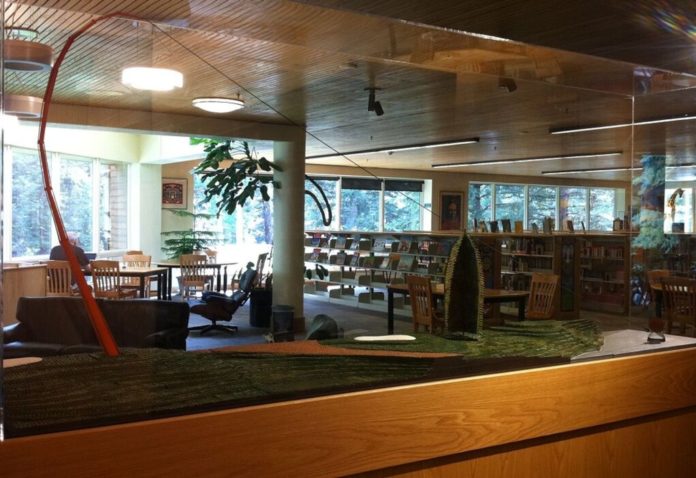This is the third story in a three-part series.
Special to the Daily
This summer, the GoPro Mountain Games extreme sports competition will host its second year of a new event where whitewater rafters take on the Eagle River while simultaneously seeing how many fish they can catch.
This competition, taking place within this premier venue for action sports, proves the thesis that the art of fly-fishing has officially made it to the realm of the extreme. Now, if only we had an extreme representation of fly-fishing through art to commemorate its arrival?
The most valuable piece of art in the town of Vail’s collection at the moment is quite likely a model of a fishing pole hooking a tin can by Claes Oldenburg and Coosje van Bruggen. The model is a small-scale representation of an idea Oldenburg and van Bruggen had for the area near Chair 8 along Gore Creek in Lionshead, where the pole would have stood 60 feet tall.
The 60-foot-tall version of Oldenburg and van Bruggen’s fishing pole is fun to imagine in 2021, where 60-foot-tall structures are commonplace in Lionshead. In 1983, a humorous observation from Council member Ron Todd was that the piece won’t attract guests as they won’t have to get off the freeway to view it. Today, it’s doubtful that the sculpture would be visible at all from the freeway, as the towers of the Arrabelle hotel in Lionshead rise to heights of more than 80 feet off the ground.
The fishing pole element of the sculpture was questioned by residents at the time in a type of thinking along the lines of: “Vail is a ski town, not a fishing town.“
“I’ve been fishing in Canada and skiing in Vail,” Steve Damman of Madison, Wisconsin, wrote to the Vail Trail in 1983. “How about a 60-foot-tall metal piece cast to look like a ski?”
Vail Trail columnist John Jansen wrote: “A fishing pole is not really appropriate for the major ski mountain in Colorado.”
A few decades later, the town of Vail and Vail Mountain would undertake wide-scale efforts to market the area as a fly-fishing destination. In 2016, Vail hosted the World Fly Fishing Championships, marching teams from more than 25 countries through Lionshead, just steps from where Oldenburg and van Bruggen’s fishing pole and tin can would have been stationed.
But while the community questioned the pole, the hesitation from Todd and others on council was directed more toward the tin can on the end of the line. The can, in 1983, was criticized as a metaphor for the destruction of nature, with Council member Chuck Anderson saying the piece went against “the very strong environmental values” of the community.
The viewing of the can as a metaphor for environmental destruction was a leap in symbolism which Oldenburg decried, saying the stream would transform the can into nature as it decays.
But if environmental destruction was seen by people at the time, they weren’t wrong. Thirty years later, Gore Creek made the state’s list of impaired waterways as development along the creek contributed to a decline in macroinvertibrate bugs, an overall indicator of poor stream health.
Oldenburg, in 1983, pointed out that Gore Creek created Vail.
“I realized the essence of this particular site was the water, the creek,” Oldenburg told the Vail Town Council. “I’ve always had the feeling that the subject of Colorado is water, not mountains. The creek and the water in the creek is the creative element in the Rocky Mountains. It has shaped the Rocky Mountains and this valley.”
Oldenburg said the fishing pole was meant to emphasize openness.
“It leads the mind into space, and down the river,” he said.
Oldenburg and van Bruggen’s final piece together debuted March 26 at Pace Gallery in New York. Oliver Shultz, the curatorial director at Pace and an Oldenburg/van Bruggen expert, said all of Oldenburg and van Bruggen’s sculptures were created as a result of the spaces they were to occupy.
“It’s not as through Oldenburg and van Bruggen made sculptures, and then later decided where to put them. They always came up with their work as a response to the place it was going to be,” Shultz said. “[The Vail project] was something where they thought very carefully about its site, and about the nature of time, and about the changes — population and development and the economy — and all of those things that now look very different from the perspective of the present, and make the work perhaps look more prescient.”
And in a final bit of foreshadowing, a Vail Trail story from September 1983 outlined the bandwagon effect in mass media which would go on to define the coverage of the 24-hour news outlets in the years to come. The story even went as far as suggesting this effect could be a bad thing, although many in Vail were loving the attention the resort was receiving.
The large amount of national attention the Oldenburg-in-Vail story received was somewhat unexpected, and the Vail Trail sought to explain it by interviewing the Associated Press about why they chose to feature the proposed sculpture in their U.S. coverage.
“One, you had an internationally recognized artist and you had a community as famous as Vail,” the AP told the Trail. “Those two things — the artist and Vail — plus the fact that you have a conflict in a community that’s well known … made it a national story.”
The bandwagon effect then proceeded.
“The editors in New York, who hook up with their international editors and one in Washington and Chicago to draw up the daily list, bought the story,” Vail Trail reporter Duane Thompson wrote in the paper’s Sept. 9, 1983 edition. “The result was a sort of bandwagon effect that, for good or bad, the U.S. media often jumps on.”
Credit: Source link































